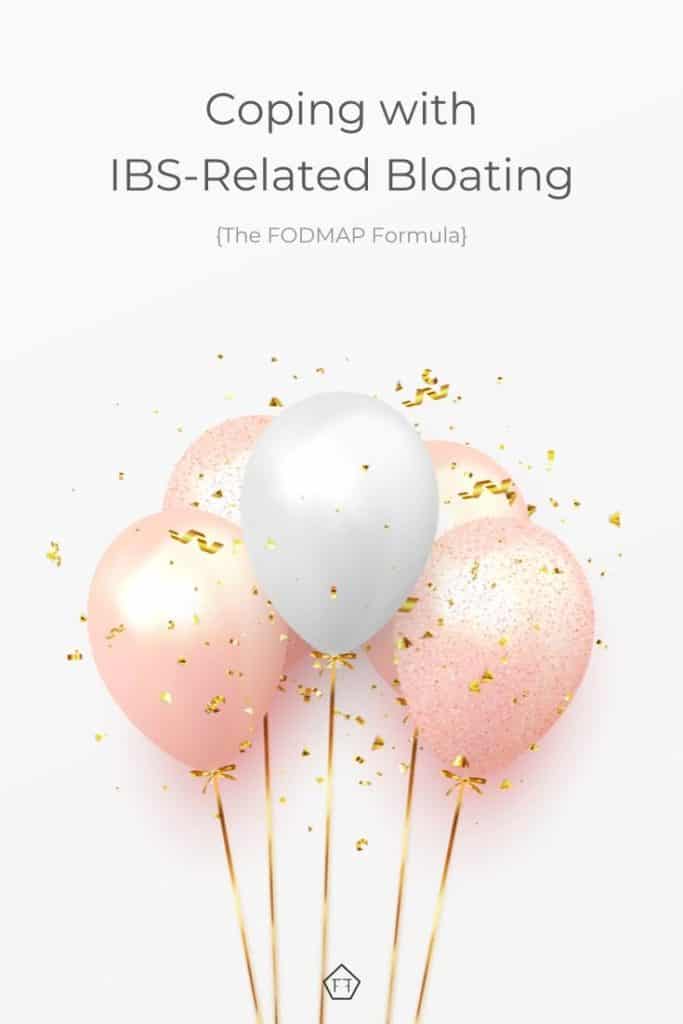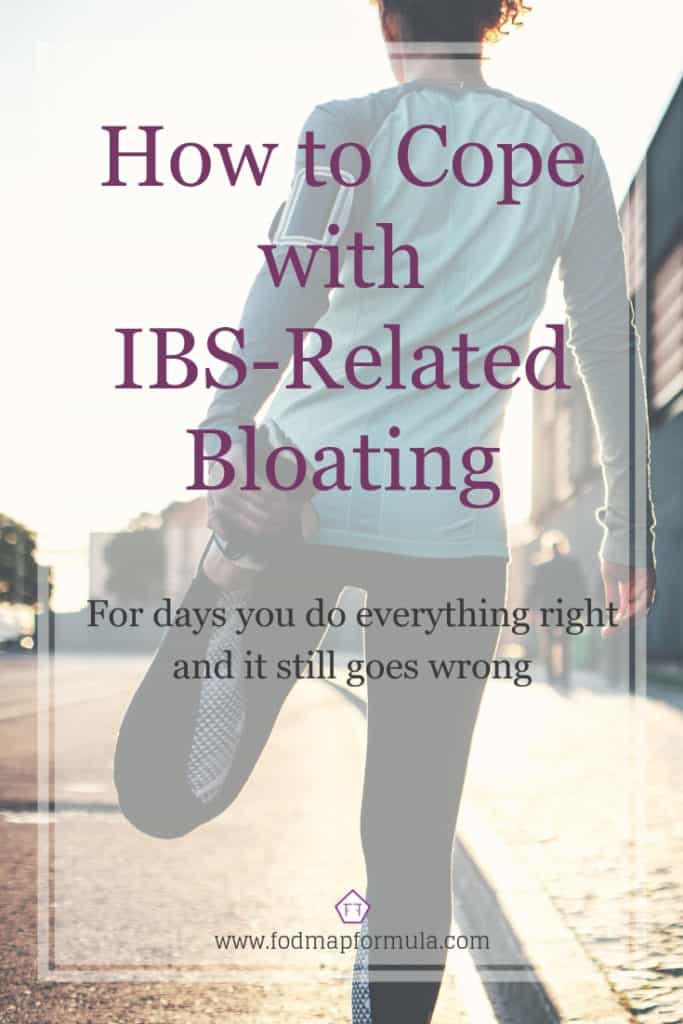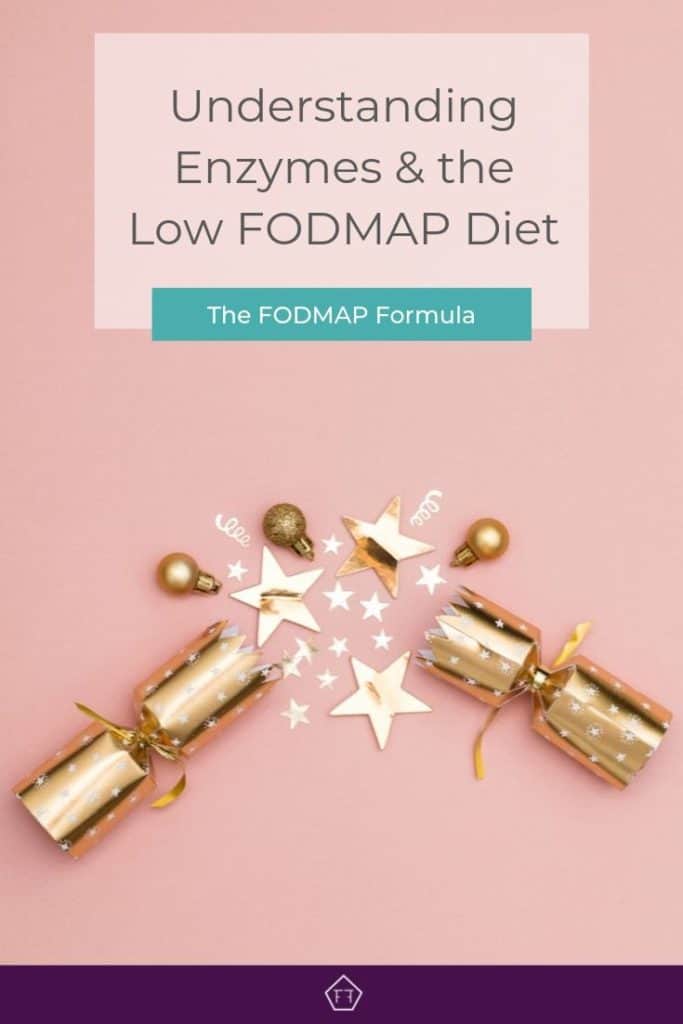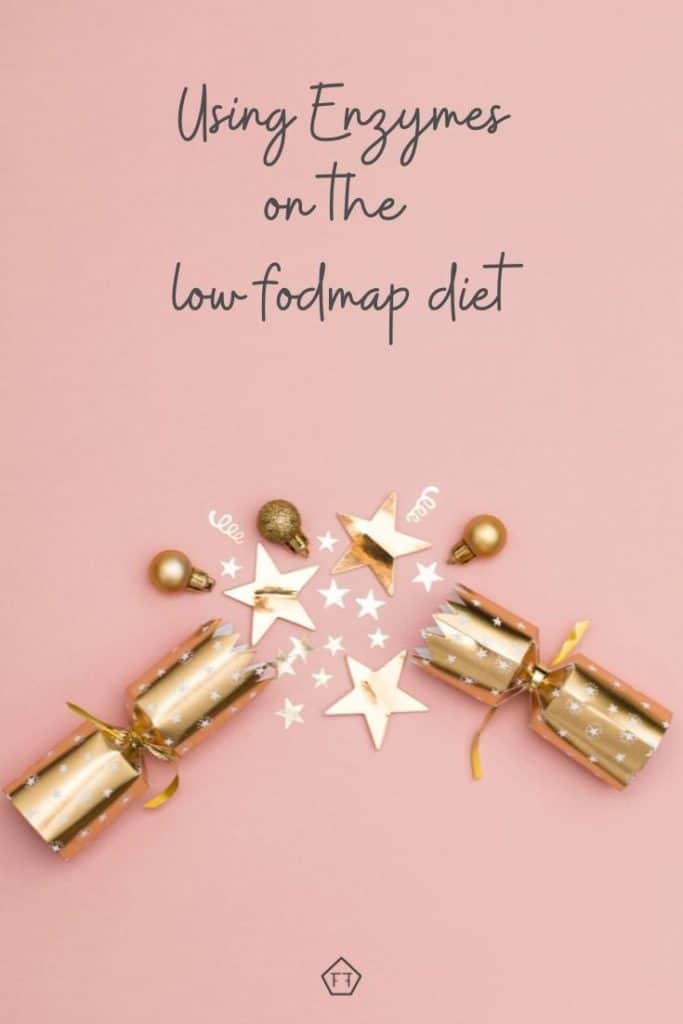Have you ever wondered if you can sneak a few high FODMAP foods into your low FODMAP program by using enzymes? In this article, we’ll talk about what enzymes do, what they’re used for, and the impact they may have on your low FODMAP program. Grab your spectacles, friend! We’re about to go full nerd!

What are enzymes, and how do they work?
While food can be pretty tasty, it’s really just fuel for your body. So while you sink your teeth into that yummy pizza, your body is hard at work, breaking it down into “vital nutrients” like proteins, fats, carbohydrates, vitamins, minerals, and water.
Just so you know, each component needs to be pretty small to be absorbed into the bloodstream. That’s where enzymes come in!
For the record, enzymes are catalysts, which means they help create changes that can’t happen on their own, or would take too long to have any real benefit. In digestion, enzymes are used to break down the bonds holding molecules together (like the bonds between FODMAPs). But how, exactly, does n enzyme do that?
Each enzyme has a specific shape that only accepts certain kinds of compounds (like a lock that only accepts one key). Lactase, for example, is used by the body to break lactose into smaller building blocks (glucose and galactose). When a lactose chain snuggles into a lactase enzyme, the edges of the enzyme start to hug the sides of the lactose molecule. This puts tension on the bond between the glucose and galactose molecules and causes them to break apart.
Think of it like opening a pickle jar. The lid is glucose, the jar is galactose, and your hands are the enzyme. If the jar is chilling out on your counter, it probably won’t open on its own (unless you have ghosts, but technically that doesn’t count). When you hold the jar in your hands and give it a good twist (or 5) the lid and the jar will separate. You, my friend, were the catalyst!
How do enzymes help with digestion?
There are lots of different enzymes in your digestive system, and each of them has a specific job to do.
Have you ever heard the phrase “digestion starts in the mouth?” They’re not kidding! The first wave of digestive enzymes your food encounters hangs out in your saliva.
Pretend you’ve just answered pizza’s siren call. As you lift that greasy little slice to your lips and prepare to indulge in a deluge of salty cheese, savoury sauce, and a concoction of low FODMAP toppings only a true FODMAPer would love, your mouth starts to water!
While drolling over a good slice of pizza is highly acceptable, what most people don’t know is that there is an army of enzymes gathering under your tongue!
There are a few enzymes found in our saliva. Each of which starts breaking down whichever carbohydrate or protein it specializes in on contact.
The longer you chew, the longer they have to work, so feel free to take a second or two to savour each bite! You’ll be doing your gut (and your taste buds) a favour!
Enzymes found in the stomach
Once you swallow your food, it travels to down the esophagus to your stomach, where it’s broken down both mechanically (by your stomach squishing and churning it) and chemically.
From the chemical perspective, your stomach is a master multitasker, unleashing a cocktail of hydrochloric acid, enzymes, and mucus (ew) into the stomach to help break down your food.
Once food enters your stomach, it will stay there for anywhere from 20 minutes to 2 hours. During this scheduled break, your stomach muscles will massage the gastric juices into your food, and break it down into a uniform liquid (called “chyme”) while your pancreas, gallbladder, and liver prep for the final stages of digestion!
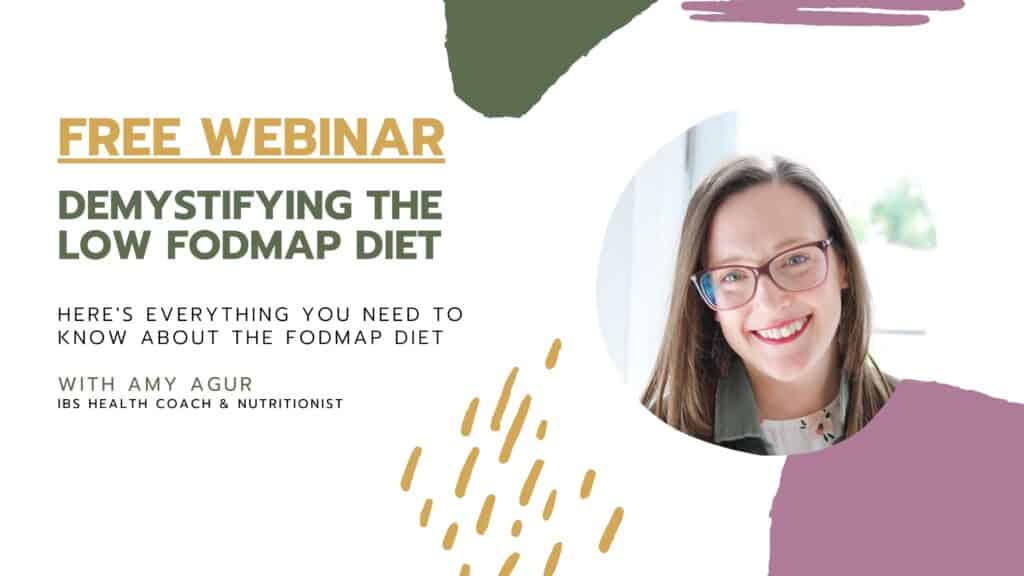
Enzymes found in the intestines
When your brain gives the go-ahead, a sphincter at the base of the stomach (called the “pyloric sphincter”) opens and plops a small amount of chyme into the small intestine.
The chyme is released in small batches over the next 1-2 hours. This process is called “gastric emptying,” and is time-released to help manage the volume of chyme sitting in the intestine at one time.
Heads up, the small intestine is divided into three sections (the duodenum, jejunum, and the ilium). Most of the heavy lifting of intestinal digestion happens in the first section of the intestine (the duodenum). The final two sections of the small intestine and the large intestine (also called the colon) are mostly used to absorb vital nutrients and water into the bloodstream.
Just like the mouth and the stomach, the small intestines are also packed with specialized enzymes. But, unlike the enzymes in your mouth and stomach, the enzymes in your small intestine aren’t floating around on their own. Instead, these enzymes are tethered to tiny bristles along the lining of the small intestine (called villi). Each enzyme is tethered next to a transporter (like a shuttlebus) that whisks away the molecules broken apart by that particular enzyme. Pretty nifty, right?
One example of this would be the enzyme lactase. Lactase helps break the bond between lactose molecules, leaving behind one glucose molecule and one galactose molecule. Once separated, these molecules are small enough to be absorbed into the bloodstream through specific transporters, conveniently located right to the lactase enzyme that broke them down.
Digestion in the large intestine
By the time the chyme enters your large intestine, all that’s left is undigested food, fluids, and dead cells from your digestive tract (um, ew). It’s basically waste.
While the chyme works its way through the large intestine, any remaining water should be absorbed, and the liquid chyme will become dried out stool.
During this process, your gut bugs chow down on any undigested foods. While they’re munching, they produce essential nutrients like fatty acids (which our bodies can’t produce on their own), chemicals that help our gut talk to our immune system and our brains, and a ton of other nifty tricks.
While they’re busy munching on your food, they also produce gas as a byproduct of fermentation (um, thanks but no thanks!).
Once your stool has moved to the end of the large intestine, a final peristalsis wave will push the stool into the rectum where it’s stored until you’re ready to poop!
Can I Take Enzymes on the Low FODMAP Diet?
So, now that you know what enzymes are and what they do, you may be wondering if you can take an over the counter enzyme to sneak some high FODMAP foods into your low FODMAP diet.
The short answer is, it’s complicated…
There are a few digestive enzymes on the market right now. But not all of them are appropriate for the first or second phase of the Low FODMAP Diet. Let’s go through them one by one, so you know what’s what.
Enzymes for Lactose
Many people with IBS suffer from “lactose intolerance.” This means a person’s small intestine doesn’t produce enough of the enzyme lactase to break down the amount of lactose found in a typical diet.
Monash University recommends using lactose-free products in the first and second phase of the program (unless, of course, you’re testing lactose). But are all lactose-free products created equal? Definitely not!
First of all, when you see a commercial product labelled “lactose-free,” it means the manufacturer has added the enzyme lactase for you (thanks, friend!). Heads up, to be labelled lactose-free in North America, a product must be 100% free of lactose, so this type of product doesn’t contain any FODMAPs, and you can eat it freely.
Remember, this doesn’t mean the lactose has been removed, just that the glucose and galactose molecules have been broken apart for you.
If you don’t have access to lactose-free products, you can also take oral lactase pills when eating dairy-containing foods. Or, you can add lactase drops to liquid dairy products (but you’ll need to let them rest for at least 24, so they can do their magic).
Both lactase pills and drops are usually available from pharmacies and grocery stores. But, unless you’re a chemist, you’ll never know if you’ve added enough lactase to compensate for what you’re eating. So it’s not always clear whether you’ve lowered the lactose content enough to prevent a reaction.
This is something you should be aware of, because if you think you’re using a lactose-free product and you’re not, you may continue to have symptoms during the elimination phase or skew the results of your re-challenges. I recommend using lactose-free products where possible and sticking to green servings of other dairy products during your low FODMAP program. If you are using lactase pills or drops and you’re still experiencing symptoms, try switching to low FODMAP servings of other dairy products or using dairy-free alternatives until you’ve completed your re-challenges.

Enzymes for Fructose
Fructose is a monosaccharide (a single sugar molecule). Since it’s already small enough to be absorbed, the body does not make an enzyme to break it down.
That being said, there is an enzyme available called xylose isomerase being marketed to people with fructose sensitivity. Studies have claimed this enzyme can turn fructose molecules into glucose molecules. There are currently two studies supporting their claim. One study completed in 2012 and another completed in 2017.
Both studies showed that people who ingested this enzyme when eating fructose had lower levels of fructose after a breath test than those who hadn’t. But there isn’t enough research to determine how much of the enzyme you would need to make foods high in fructose low FODMAP. So, this enzyme is not appropriate for the first or second phase of the program.
Enzymes for GOS and Fructans
Just like fructose, our bodies don’t make enzymes to break down oligosaccharides like GOS or fructan. In fact, many oligosaccharides belong to a particular group of foods called “prebiotics,” which are an essential source of food for your good gut bugs. So you don’t necessarily want to break them all down.
Prebiotics aside, just like with the fructose enzyme, you have no way of knowing how much of the enzyme you would need to make a food truly “low FODMAP.” So this enzyme is not appropriate during the first or second phase of the program, either.
Final Thoughts Plus
Most dietitians recommend sticking to lactose-free products and saving any additional enzymes you want to try for after the reintroduction phase. While enzymes may be helpful to you, the point of the elimination phase is to create a clean system to test each FODMAP group.
If you continue to eat high FODMAP foods during the first phase of the program, you won’t know if you’ve skewed some of your tests. Or worse, if the enzyme doesn’t make your food truly “low FODMAP” you might have symptoms during the elimination phase and think the program isn’t working for you.
As a side note, until you’ve finished your re-challenge tests, you still don’t know if you’re even sensitive to that FODMAP group. So you might waste a lot of money trying to fix something your body is doing correctly.
The moral of the story is, if you want to try adding an enzyme to help manage your symptoms, your best bet is to follow the elimination and re-challenge phases as they were designed and test out any enzymes as you develop your personalized long-term diet.
You might also like one of these articles:
- Is sugar low FODMAP? Have questions about sugar and the low FODMAP diet? Check out this article for everything you need to know about the sweet stuff and your gut!
- Can food sensitivity tests identify food triggers? Wondering if a food sensitivity test can help you identify your IBS triggers? Here’s everything you need to know about food sensitivity tests and what they mean for people with IBS.
- Is your gluten sensitivity really an intolerance to fructans? Gluten isn’t the only thing in your grains that can turn your tummy! Check out this article to understand the difference between gluten and fructan sensitivity and how to find out which one you’re actually reacting to.
If you like this post, don’t forget to share it! Together we’ll get the low FODMAP diet down to a science!
